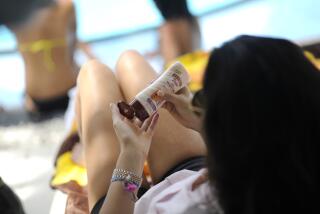Sun sense slips after baby’s first summer
- Share via
That first summer, most new moms and dads wrap their newborns in long-sleeved jerseys, shelter their faces from the sun with wide-brimmed hats and keep them in the shade. The second summer, though, parents slack off, and children get less sun protection and more burns.
“The beginnings of sun damage can start at a much earlier age than we thought,” said Alan Geller, a professor of epidemiology at Boston University’s School of Public Health and a professor of dermatology at the university’s School of Medicine.
In a study of how new mothers protected their young children from the sun, Geller and his colleagues found that skin damage rates increased significantly from 22% for 6-month-olds during their first summer to 54% for 18-month-olds during their second summer. Although 90% of mothers reported using sunscreen on their toddlers, the increased sunburning and tanning resulted from lack of sun protection rather than increased sun exposure, the study found.
“This is a warning signal to the public to say: What can we do to prevent damage to our youngest children?” Geller said.
The researchers also studied whether an intervention program immediately following childbirth could affect new mothers’ sun protection practices. In the study, 45 women received counseling from nurses on sun protection techniques, plus written materials and follow-up telephone counseling; 47 women received only sun-protection counseling.
Subsequent surveys showed that both groups experienced a decrease in the routine use of sun protection from the first summer to the second summer of a child’s life. However, the increase in skin damage for children in the intervention group was 32%, while that of the control group was 43%.
Excessive sun exposure is an issue for people of any age. Many skin cancers diagnosed in the United States are caused by burns and tanning from too much time in the sun without protection. Although an earlier study showed that sun protection dropped significantly between the ages of 9 and 14, this latest study shows the problem starts much earlier.
Parents should not use sunscreen on infants younger than 6 months. Instead they should keep their babies out of direct sunlight, according to the American Academy of Pediatrics.
Geller says sunscreen should be applied frequently, liberally and thickly. A normal-size child requires about a palmful. But, he said, parents should also make sure their children wear hats and long-sleeved shirts, if possible, and that they play in parks with more trees for increased shade.
He also suggests that community groups work to improve shading on school playgrounds and that hospitals educate new mothers on the importance of sun protection. After that, sun protection comes down to developing good habits.
“Make it fun, start it early, and make it nonnegotiable,” Geller said.
Results of the study appeared in the August issue of the Archives of Dermatology.






